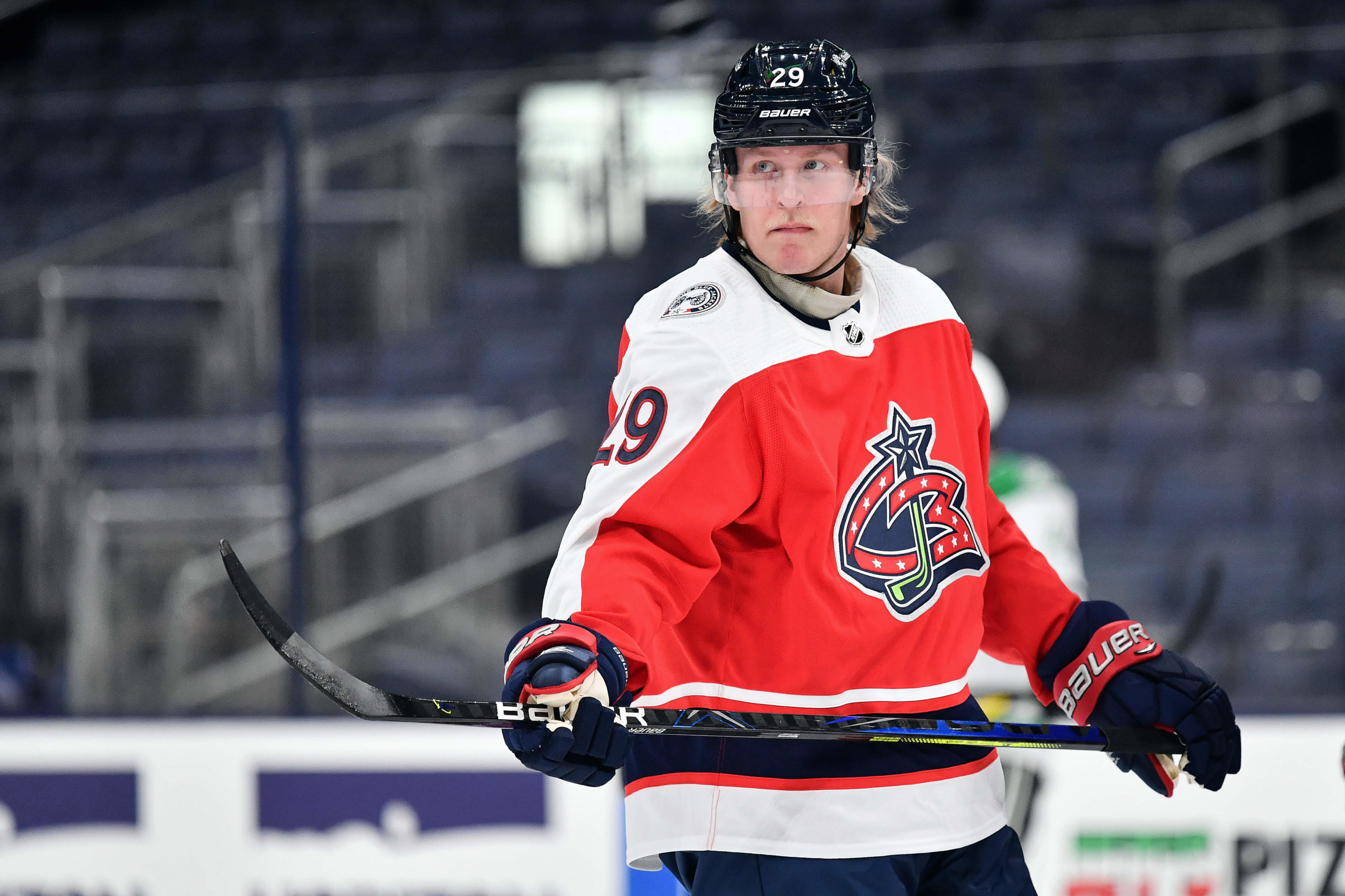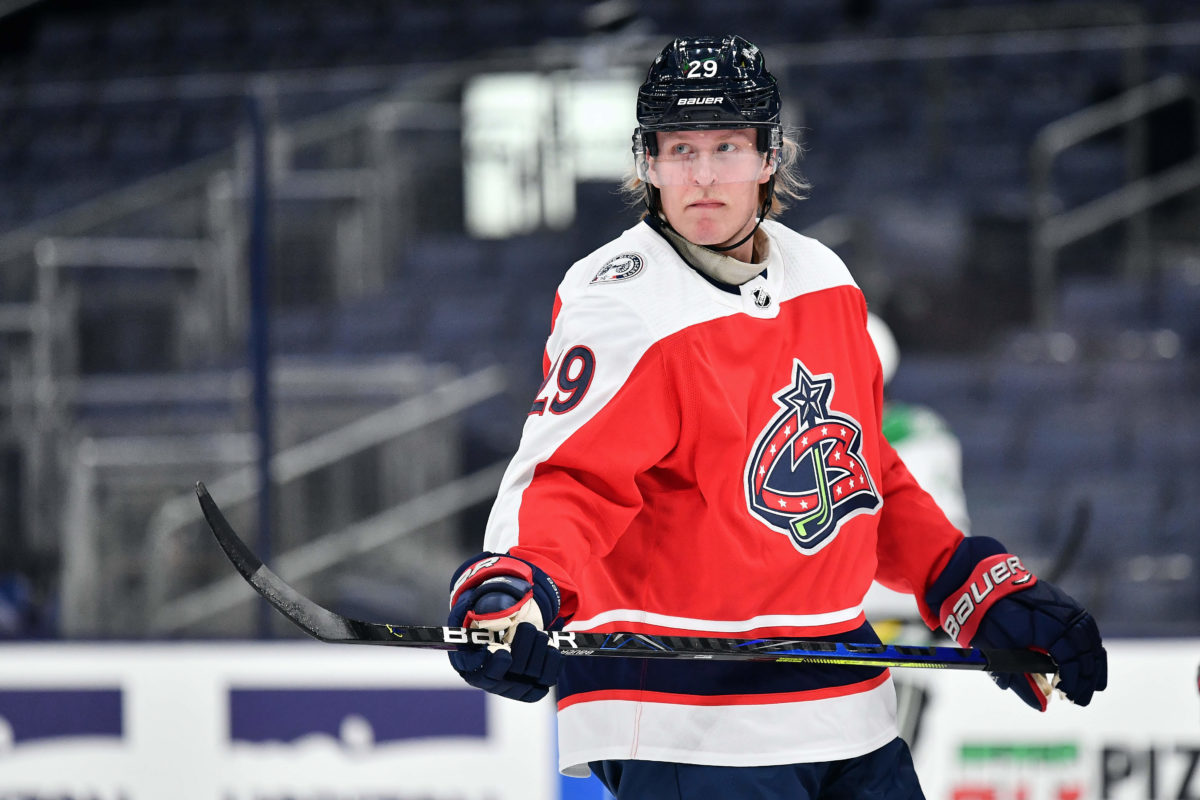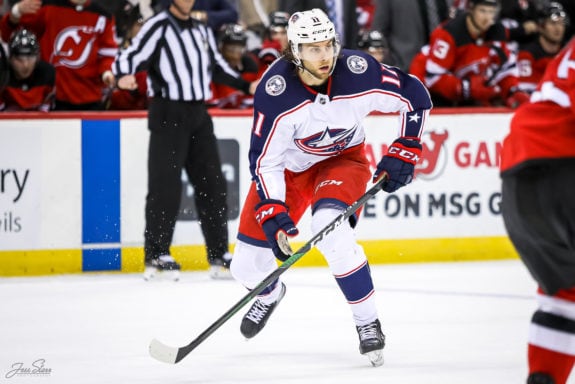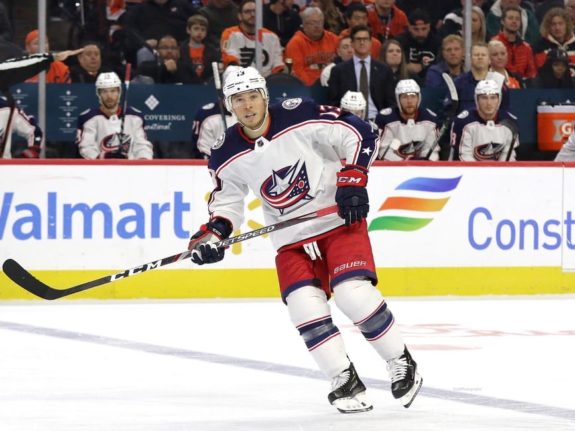
Most of the talk about the upcoming Seattle Kraken Expansion Draft revolves around various teams’ “protected lists” – the players that they want to keep. However, some teams, including the Columbus Blue Jackets, need to look at their “exposed lists” – those players from whom Seattle can select. Right now, Columbus can’t use all of its slots on the protected list and still meet the minimum requirements for exposed players.
If you’re following the expansion draft, you know that teams can protect seven forwards, three defensemen, and one goalie or they can elect to protect eight skaters and a goalie. (The latter option likely would be chosen by a team needing to protect more than three defensemen.) However, little attention is being paid to the flip side of that coin: Each team must leave exposed at least two forwards, one defenseman, and a goalie from whom the Kraken can choose. The players must meet certain eligibility requirements.
What Are the Exposure Rules?
Each team must have available two forwards, one defenseman, and one goalie who meet these requirements:
- Each skater (forwards and defensemen) must be under contract for 2021-22.
- Each skater must have appeared in either 27 games during the 2020-21 season or 54 games total during last season and the season prior.
- The goalie must either be under contract for 2021-22 or a restricted free agent (RFA) at the end of this season.
The Blue Jackets shouldn’t have a problem meeting the exposure requirement for defensemen or goalies, but if the club protects seven forwards, there are not two forwards available who meet both of the criteria.
Which Blue Jackets Meet the Exposure Requirements?
Per CapFriendly.com, here’s the current Blue Jackets list of players who meet the requirements to be selected by the Kraken:
Forwards: Cam Atkinson, Oliver Bjorkstrand, Max Domi, Boone Jenner, Gus Nyquist, Eric Robinson, and Jack Roslovic (seven total).
Defensemen: Vladislav Gavrikov, Dean Kukan, Seth Jones, and Zach Werenski (four total).
Goalies: Cam Johnson, Matiss Kivlenieks, and Joonas Korpisalo (three total).
Keep in mind that the Blue Jackets are likely shopping either Korpisalo or goaltending partner Elvis Merzlikins. If Korpisalo is traded, Columbus can protect Kivlenieks and still meet the goalie exposure requirement. (That trade may happen before the expansion draft, although I have presented the argument that a goalie trade should wait until their trade value increases.)

Jones, the team’s top defenseman, has informed the organization that he has no intension of signing a long-term contract with the Blue Jackets. Trading him this summer, while he still has a full year on his contract, makes sense. If that trade happens before the expansion draft, the club could protect all three of the defensemen who meet the exposure requirements, but then they’d need to find another defenseman who can be exposed. Michael Del Zotto is the only other D-man who meets the “games-played” requirement, but he’s a pending unrestricted free agent. The club would need to sign him to expose him (and they might not want to lose him, especially if Jones is out the door).
As far as forwards are concerned, only three whose NHL rights belong to Columbus have met the games-played requirement, but are not under contract for 2021-22: Patrik Laine, Kevin Stenlund, and Mikhail Grigorenko.
Who Are the Blue Jackets Likely to Protect?
At first glance, the Blue Jackets protected list looks like a no-brainer: Protect all seven forwards, defensemen Jones, Werenski, and Gavrikov, and goalie Korpisalo. If the club trades Jones soon, it could elect to go with the eight skater/one goalie option and protect defensemen Werenski and Gavrikov, and six forwards. But, which six? Here are some pros (why the Blue Jackets should protect the player) and cons (why the Kraken might not want to select the player):
- Atkinson Pros: He tied for second in team scoring during 2020-21 with 15 goals and 34 points (which is equivalent to 22 goals and 50 points in an 82-game season). He’s a former 40-goal scorer and if we pro-rate his past two shortened seasons, he’s been a 20-goal scorer for eight straight years. He’s an alternate captain and provides solid leadership. Cons: He just turned 32 and has four years left on his contract at $5.875 million average annual value (AAV). He’ll be 35 years old during the last season of his contract. Seattle might not want to take on that contract at his age and with the likelihood of declining production.
- Bjorkstrand Pros: He led the team in scoring with 18 goals and 44 points (equivalent to 26 goals and 64 points) and was one of only four Blue Jackets to play in all 56 games last season. He’s shown year-over-year increases in production. He’s 26 years old and under contract for five more years at what should look like a great bargain of $5.4 million AAV.
Cons: Absolutely none – count on him being protected. - Domi Pros: He’s a natural center, the team’s greatest weakness. He finished last season pretty strongly, scoring half of his 24 points in the final 17 games. He said all the right things in his “exit interview” (the mini press conference following the end of the season), expressing a very strong desire to work harder, get better, and stay in Columbus. In 2018-19, the most recent “regular” season, he scored 28 goals and 72 points in 82 games. His advanced stats are pretty good (as reported by Hockey-Reference.com).
Cons: He recently had shoulder surgery that will keep him out of the lineup until November at the earliest. Then, of course, he needs to work himself back into top game form. He has only one season left on his contract and likely will miss up to half of that season. One important part of playing center is winning faceoffs, and Domi’s career record in the circle is only 46.4 percent. - Jenner Pros: Leadership. He can play center or wing and chip in some offense from the third line. He is a faceoff ace (55.1 percent in 2020-21, career 54 percent). He still has a year left on a very team-friendly $3.75 million contract.
Cons: He only has one year left on his contract. He’s a career 20-point man, so there’s not a lot of offense there. He ended the season on the injured reserve list and has only played every game in a season twice in an eight-year career. - Nyquist Pros: The players in the room look up to him and he’s considered a strong, stable leader. His career scoring works out to about 50 points per 82 games. If he doesn’t fit into the club’s long-term plans, he’s the sort of player who (if healthy) should be in high demand at next year’s trade deadline.
Cons: He missed all of last season after shoulder surgery. He’s 31 years old and only has two years left on his contract ($5.5 million AAV), so what will he be asking for when he becomes an unrestricted free agent? - Robinson Pros: He’s fast. Really, really fast. And big (6-foot-2, 200 pounds). Three of his eight goals and six of his 18 points last season came in the final seven games. At age 26, he seems to be showing the NHL potential he demonstrated in the AHL and NCAA. He has one year left on his $975,000 AAV contract. Recently named new head coach Brad Larsen (who spent the past seven years as an assistant coach in Columbus) thinks very highly of Robinson and his speed.
Cons: While he has the potential to be a real steal, he’s still “potential” rather than “proven.” (But let’s remember former Blue Jacket William Karlsson – Columbus basically begged the Vegas Golden Knights to select him in their entry draft. A third- and fourth-line part-timer in Columbus, he scored 43 goals in his first season with Vegas.) - Roslovic Pros: He’s a center. He has the potential to be a very good center. (He promises to work hard on faceoffs.) His 34 points last season (tied for second the team) was a career high, despite playing only 48 games. Two of his goals and four of his points came in his last four games. While he’s not likely to be that true first-line center the club desperately needs, he certainly could grow into a fine second-line center. He has one more year on his current contract, with an AAV of a bit over $1.8 million. He’s only 24 years old.
Cons: He’ll be a RFA with arbitration rights after next season. If he has a good year, how big will his next contract be?
So, which of the seven forwards would be left off the protected list? Would the Kraken value defenseman Kukan or goalie Kivlenieks more than aging veterans Nyquist and Atkinson? Would they bypass the potential of speedy Robinson or injured Domi? Keep in mind, too, that if Korpisalo is traded and the Blue Jackets can protect Kivlenieks, the choice could come down to Kukan or a forward since goalie Johnson doesn’t look to be an option for the Kraken, who can select only three goalies total.
Latest Blue Jackets Content:
Blue Jackets: Brad Larsen Hiring Hints at What’s Coming Next
Tortorella: In the Words of His Players
Blue Jackets Have Mixed Results at World Championship
Blue Jackets Rebuild Coming With Seth Jones News
Does Patrik Laine Need to be Protected?
Technically, Laine does not need to be protected because he is not under contract for the 2021-22 season. However, the Blue Jackets might opt to use one of the forward slots on him (which, of course, means one of the players mentioned above needs to be left unprotected).

Little-known fact: The Kraken can sign one of a team’s unprotected free agents during an exclusive negotiating period July 18-21. That player counts as the player selected from that team. Here’s the kicker: Normally only a team that already holds a player’s rights can offer an eight-year contract (other teams can offer up to seven years). During this window, the Kraken can also offer eight-year contracts. What if they decide to offer such a contract to Laine? It would be a contract that the Blue Jackets don’t have the option of matching, as they would with an offer sheet from another team.
So, What’s the Problem?
Rules are rules, and the expansion draft rules say each club must make players available to the Kraken. Right now, for the Blue Jackets to meet the eligibility requirements for forwards, the club would need to leave exposed players it could technically protect (and those are players the club likely does want to keep). Likewise, if Jones is traded prior to the expansion draft, a defenseman who could be protected would have to be made available.
What Are the Possible Solutions?
One option that’s off the table is signing another team’s free agent to sign and expose – free agency doesn’t begin until July 28, a week after the expansion draft. The Blue Jackets can, however, sign their own free agents. As mentioned earlier, the list of Blue Jackets free agent forwards who meet the exposure requirements consists of Laine, Stenlund, and Grigorenko. Signing Laine only to leave him exposed is a non-starter. Stenlund? Possible. But, does the club prefer Stenlund to, say, Robinson?

Grigorenko would have been a nice option, but he has reportedly signed to play next season in the KHL. Aaron Portzline of The Athletic cited Grigorenko’s agent, Dan Milstein (“Blue Jackets Sunday Gathering: Is a total rebuild coming? Plus, a wild idea for those late first-round picks,” 6/6/21). There’s also a report from the Russian website Sport-Express that says KHL club CSKA Moscow bought out the contract of forward Ivan Telegin to create cap space to bring back their former star. (A good summary of the Russian article is on ProHockeyRumors.com.)
However, signing and exposing Stenlund would solve only half of the problem – two forwards need to be available to the Kraken. Leave one of the older players available? Maybe. But does Columbus really want to risk losing Nyquist or Atkinson?
The Blue Jackets can also trade for players who meet the exposure requirements. A number of teams have more eligible forwards than they can protect, but how cheaply can they get such players? Does a pair of such players come cheaper than, say, the value of two from Stenlund, Robinson, Atkinson, and Nyquist? Oh, and don’t forget this: What can the club do with a player or two obtained just to meet the expansion draft exposure rules if not selected? Can they find exposable players who are also disposable?

Ah-ha! Pay little for a player who meets the exposure requirements and has a low AAV contract, perhaps with only a year or two left, and maybe even a two-way contract that can be sent to the AHL! Browsing the lists at CapFriendly shows bunches of RFAs and some UFAs who meet the exposure requirements. The Blue Jackets could probably trade for the rights to a couple of them reasonably cheaply, make them qualifying offers, then expose them in the expansion draft.
What Will the Blue Jackets Do?
I don’t know. Trying to read the minds of creative thinkers like general manager Jarmo Kekäläinen and President of Hockey Operations John Davidson is not something I want to do. At least publicly. But they have to do something by July 17. That’s the deadline for trades among the 31 non-Seattle clubs (3 PM) and the deadline for the final protected list to be submitted to the league and the players’ union (5 PM).
Pete Bauer is both a hockey fan and player. As a columnist for The Hockey Writers, he covers the Columbus Blue Jackets, NCAA hockey, and NHL trends, statistics, and history. He is also the author of over a dozen books on photography, digital imaging, and graphics, including “Photoshop CC for Dummies.”
